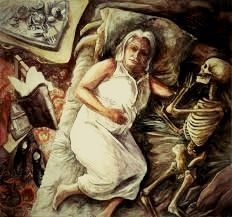Post Colonialism: I started Early – Took my Dog --
Post Colonialism: I started Early – Took my Dog --
Post Colonialism is a literary mode prevalent within the poem “I started Early – Took my Dog --” by Emily Dickinson as demonstrated through key themes such as the sea, and relation to oppression as witnessed through historical context. Dickinson was an American poet who lived in the 19th century, and although the poem itself does not directly address colonialism we can draw parallels between the authors life and the colonization during Dickinson’s time.
The historical context witnessed throughout the poem includes that of the industrial revolution, representative of desire and freedom—during this revolution the economy shifted and signaled a process of change, the transition from creating goods by hand to that of using machinery. Dickinson's works are influenced by the industrial revolution as her poetry deals with both science and more divine matters—her emphasis on the beauty of the natural world pays homage to transcendentalism, a desire for freedom against the changing times. She continuously personifies nature in a way to have it appear alien, separate from human life.
Within the poem itself Dickinson quotes:
7 "presuming Me to be a Mouse –
8 Aground – upon the Sands"
We can see that Dickinson is viewing herself as a victim, a victim to her surroundings as though a war wages on around her. This could be suggesting that the changing society is a villain to her, as the world evolves and takes away from the beauty of nature while swapping the natural world for metal and machinery. Dickinson's depiction of nature directly contrasts the colonial attitude towards the environment, amplifying the power of the environment which the industrial revolution chooses to ignore.
Dickinson focuses on the sea's power in reflecting sexual desires, viewing this aspect of nature as otherworldly and powerful. The journey of the speaker's early start, taking their dog along to the sea can be viewed as a metaphor for expansion, a central aspect of colonialism. We could also venture the idea that the speaker's agency to venture out early reflects themes of autonomy, a desire for self-governance and reclaiming identity. Betsy Erkkila wrote “Emily Dickinson and Class” regarding the impact of the social, political and cultural struggles of Dickinson’s time. She mentions the industrial transformation of the US in the nineteenth century, and how Dickinson was ‘the privileged, homebound, and socially endowed daughter of the town squire’, making note of Emily’s privilege compared to many others. Due to this, we could take note of how Emily’s poetic revolution is grounded in the privilege of her class position.
Moreover, the poem's heavy depiction of nature—specifically the sea—can be seen as reflecting the colonial attitude towards the environment, where nature is commonly viewed as something to be conquered or exploited. Whereas in this interpretation, the sea is viewed as a symbol of tranquility and divinity—something otherworldly and seemingly transcending. There are possible sexual connotations displayed through the power of the sea, possibly personifying it as a man and the idea of the unknown, as it is described as travelling,
11 "past my Apron – and my Belt
12 And past my Bodice--"
such as the actions of being undressed or touched in a sexual manner. From this we could suggest that these sexual themes are representative of the author's own desires, a suppressed urge she is only able to depict through nature. Dorothea Steiner wrote in “Emily Dickinson: Image Patterns and The Female Imagination” regarding the tradition of female writers at the time, and how Dickinson wrote poetry in order to try to ‘come to terms with her identity as a woman’, she also explains how Dickinson experienced a power struggle with existence and disguised herself by using masks within her writing. These masks can serve in reflecting her views of the world at the time, and how she sought out to separate herself from them.
Overall, the poem can be analyzed through a post-colonial lens by considering its central themes—such as exploration and attitudes towards nature, both of which are relevant to understanding the impact of colonialism on literature and society. These themes in the poem represent the changing society surrounding Dickinson and her desire to pull from the societal expectations around her to find her own self-expression.
Works Cited
https://www.jstor.org/stable/43023220
Steiner, Dorothea. “EMILY DICKINSON: IMAGE PATTERNS AND THE FEMALE IMAGINATION.” AAA: Arbeiten Aus Anglistik Und Amerikanistik, vol. 6, no. 1, 1981, pp. 57–71. JSTORhttps://www.jstor.org/stable/489934
Erkkila, Betsy. “Emily Dickinson and Class.” American Literary History, vol. 4, no. 1, 1992, pp. 1–27. JSTOR
https://images.app.goo.gl/B6e7xYxGj97xcPJB8
portrait of Emily Dickinson, circa 1850. Three Lions / Getty Images
https://online.vitalsource.com/reader/books/9780429889516/epubcfi/6/40[%3Bvnd.vst.idref%3DAppendix]!/4/10/16/3:0[%2C%20Ag]
Tyson, Lois. Using Critical Theory. Routledge, 2021.
https://t3.ftcdn.net/jpg/01/34/53/74/240_F_134537443_VendrqyXIWyHrZgxdIsfyKUost734JDP.jpg
Adobe Stock, Katatonia.
:max_bytes(150000):strip_icc()/GettyImages-3072437-8403f31f9616461594a70b1ddb9c3d7f.jpg)



Comments
Post a Comment